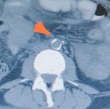Clinical relevance of uric tobacco-specific nitrosamine and severe abdominal aortic calcification in a national survey of the United States
Abstract
Background: This cross-sectional study investigated the relationship between uric tobacco-specific nitrosamine (TSNA), N′-nitrosonornicotine (NNN), and abdominal aortic calcification (AAC) in the United States (US) adults for the first time.
Methods: The final sample (2,713 participants aged 40 years and older) was obtained from the National Health and Nutrition Examination Survey (NHANES) 2013–2014. The risk of severe AAC according to uric NNN, dose–response relationship, and threshold effect were analyzed using the multivariate logistic regression models, cubic spline model, and a two-piecewise linear regression model, respectively.
Results: In the fully adjusted model, the odds ratios (OR) (95% confidence interval, CI) of severe AAC for participants in the high uric NNN group was 2.39 (1.59–3.61) compared with that in the low uric NNN group (P < 0.001). After adjusting for multiple covariates, the risk of severe AAC increased 1.515-fold for every 1 ng/dL increase in uric NNN when the concentration of uric NNN was less than 1.354 ng/dL. The association between uric NNN and severe AAC was stable among different subgroups.
Conclusion: In a sample of US civilians, uric NNN levels positively correlated with the risk of severe AAC.
Conclusion: In a sample of US civilians, uric NNN levels positively correlated with the risk of severe AAC.


